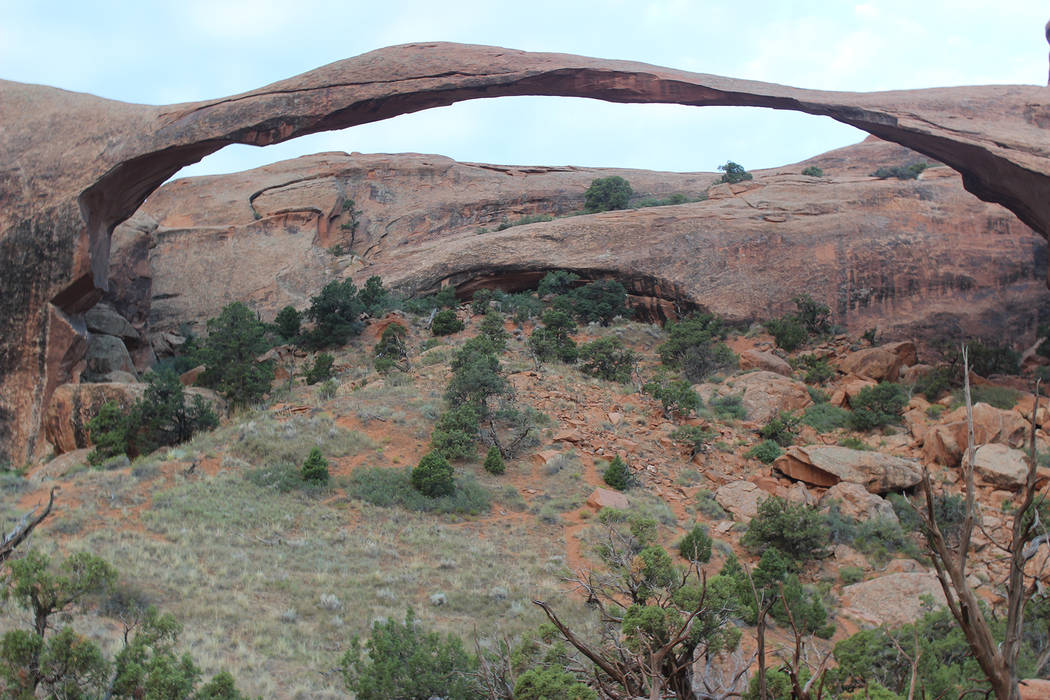
Arches National Park in Utah boasts the world’s largest concentration of natural stone arches, more than 2,000 in fact, so it’s no wonder people often spend days traveling to see the place. Fortunately for us, we live fairly near the park, about 480 miles from Boulder City.
The park has an elevation range of 4,085 to 5,653 feet, which makes November an ideal time to visit. Not only does a November visit avoid the heavy crowds seen from early spring to early fall, but this month also boasts ideal hiking temperatures, with daily highs in the 50s and 60s.
The best way to introduce yourself to the park would be taking the 36-mile Scenic Drive. There are viewpoints, overlooks and parking areas along the way to see arches, windows, spires and pinnacles, and balancing rocks.
That’s the fastest way to see the park, but setting hiking boot to trail is the most rewarding. For seeing the famed arches, the best two trails are to Delicate Arch and Landscape Arch.
Landscape Arch is an easy 1.6-mile round trip with minimal elevation gain and a good one for people of just about every age who can hike over a bit of uneven terrain. Delicate Arch is a 3-mile round trip with an elevation gain of 480 feet. Small children should not attempt the Delicate Arch hike, as there are drop-offs.
Landscape Arch has a span of 290 feet base to base and is only 6 feet thick at its center, very thin for its length. Erosion, weather and gravity are constantly wearing away at the rock and, like all arches, it could collapse at any time, so be sure to see it before it does.
In 2008, the Wall Arch, at the time the 12th-largest arch in the park, came crashing down in the middle of the night. Delicate Arch is one of the most photographed arches in the world. It is the largest free-standing arch in the park, with an opening of 45 feet at its highest and width of 32 feet.
Snow and rain this time of year can make most of the trails treacherous. Be sure to get up-to-date trail conditions from a park ranger or at the visitor center before setting out. Take along hiking shoes or boots, a daypack, water, snacks and warm clothes for layering, including a hat or beanie and gloves.
The park is open 24 hours a day year-round. The Arches visitor center is open daily except Christmas, but hours change seasonally. For more information on Arches National Park, call 435-719-2299 or visit http://www.nps.gov/arch.
The nearby town of Moab is fun to stroll around and has a wide variety of restaurants, breweries, shops, gas stations and markets as well as plenty of lodging.
If you don’t mind low overnight temperatures, the camping is super here. The park’s Devils Garden Campground is open year-round and has 52 sites. It’s reservation-only from March through October, but this time of year it’s first-come, first-served. There are also fabulous sites in and around Moab along the Colorado River, and this time of year is the best because there are no mosquitoes.
For more information, visit the Moab Visitor Center, 25 E. Center Street, call 435-259-8825 or go to http://www.discovermoab.com.
A two-night minimum stay in the area is recommended.
Many of Deborah Wall’s columns have been compiled into books about hiking in the Southwest. She is also the author of “Great Hikes: A Cerca Country Guide” and a co-author of the book “Access For All: Seeing the Southwest With Limited Mobility.” Wall can be reached at Deborabus@aol.com.